Comparative Analysis of Leadership and Management at Hotel Tresanton
VerifiedAdded on 2020/06/06
|19
|5960
|55
Report
AI Summary
This report provides a comprehensive analysis of leadership and management within the context of Hotel Tresanton, a small to medium enterprise (SME) located in the United Kingdom. It begins by defining and comparing the distinct roles and characteristics of leaders and managers, highlighting their individual responsibilities in achieving organizational objectives. The report then delves into the practical application of these roles in various situations, such as delegation of authority, decision-making processes, employee engagement, and training and development. Furthermore, it explores the application of different leadership theories and models, evaluating their strengths and weaknesses. The analysis extends to operations management, examining key approaches and the importance of efficient operations. The report also considers how factors within the business environment influence operational management and decision-making. Overall, the report provides a critical evaluation of leadership, management, and operations management within Hotel Tresanton, offering insights into how these elements contribute to the hotel's success.
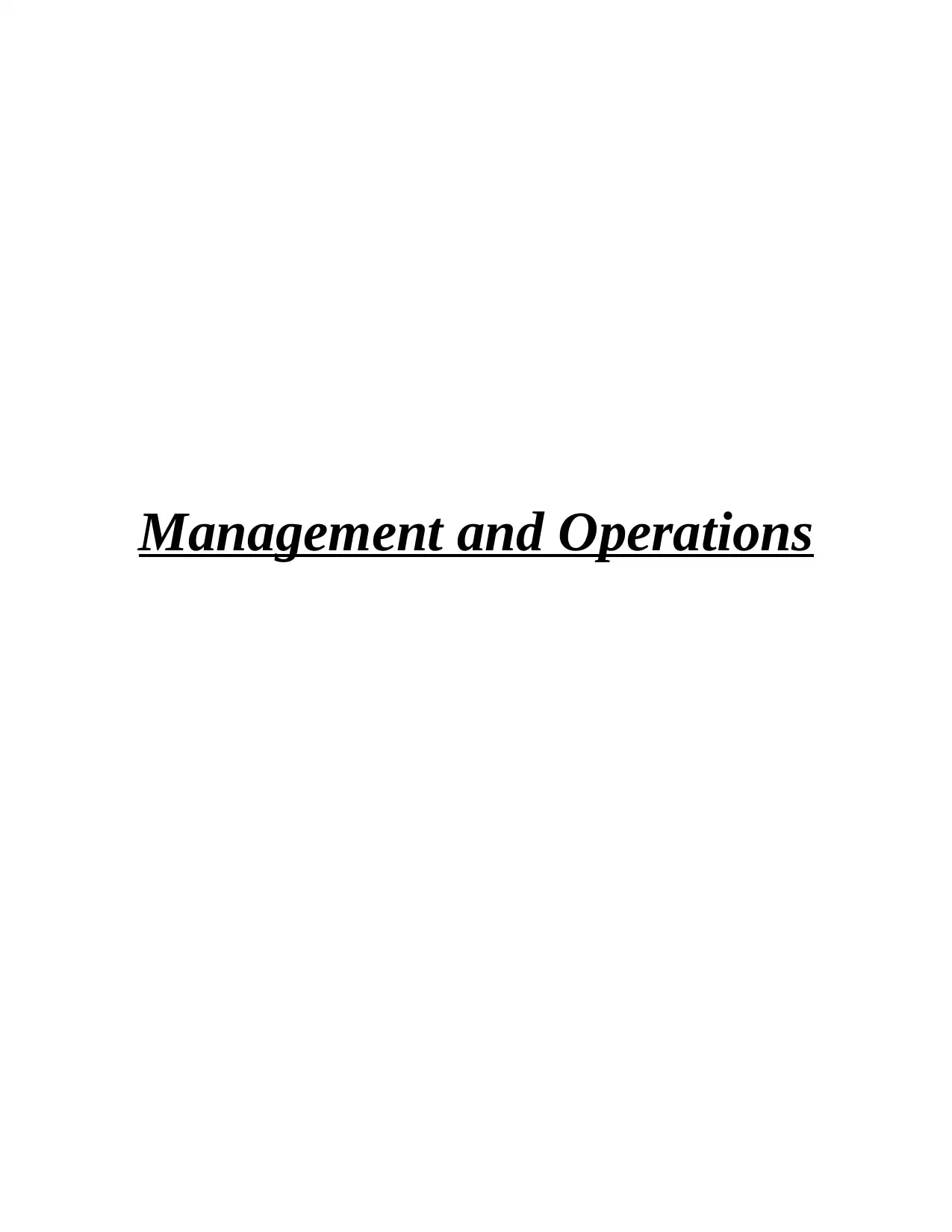
Management and Operations
Paraphrase This Document
Need a fresh take? Get an instant paraphrase of this document with our AI Paraphraser
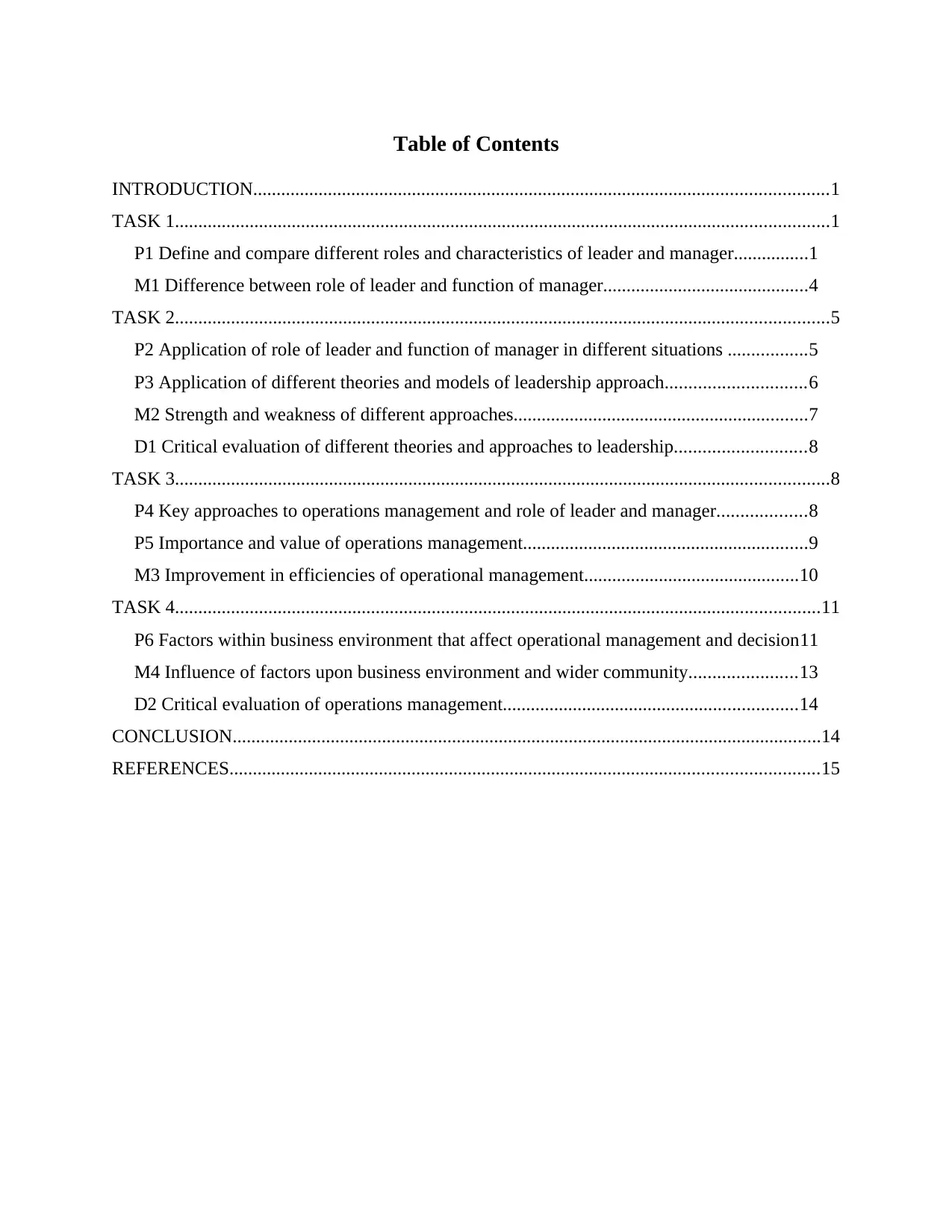
Table of Contents
INTRODUCTION...........................................................................................................................1
TASK 1............................................................................................................................................1
P1 Define and compare different roles and characteristics of leader and manager................1
M1 Difference between role of leader and function of manager............................................4
TASK 2............................................................................................................................................5
P2 Application of role of leader and function of manager in different situations .................5
P3 Application of different theories and models of leadership approach..............................6
M2 Strength and weakness of different approaches...............................................................7
D1 Critical evaluation of different theories and approaches to leadership............................8
TASK 3............................................................................................................................................8
P4 Key approaches to operations management and role of leader and manager...................8
P5 Importance and value of operations management.............................................................9
M3 Improvement in efficiencies of operational management..............................................10
TASK 4..........................................................................................................................................11
P6 Factors within business environment that affect operational management and decision11
M4 Influence of factors upon business environment and wider community.......................13
D2 Critical evaluation of operations management...............................................................14
CONCLUSION..............................................................................................................................14
REFERENCES..............................................................................................................................15
INTRODUCTION...........................................................................................................................1
TASK 1............................................................................................................................................1
P1 Define and compare different roles and characteristics of leader and manager................1
M1 Difference between role of leader and function of manager............................................4
TASK 2............................................................................................................................................5
P2 Application of role of leader and function of manager in different situations .................5
P3 Application of different theories and models of leadership approach..............................6
M2 Strength and weakness of different approaches...............................................................7
D1 Critical evaluation of different theories and approaches to leadership............................8
TASK 3............................................................................................................................................8
P4 Key approaches to operations management and role of leader and manager...................8
P5 Importance and value of operations management.............................................................9
M3 Improvement in efficiencies of operational management..............................................10
TASK 4..........................................................................................................................................11
P6 Factors within business environment that affect operational management and decision11
M4 Influence of factors upon business environment and wider community.......................13
D2 Critical evaluation of operations management...............................................................14
CONCLUSION..............................................................................................................................14
REFERENCES..............................................................................................................................15

⊘ This is a preview!⊘
Do you want full access?
Subscribe today to unlock all pages.

Trusted by 1+ million students worldwide
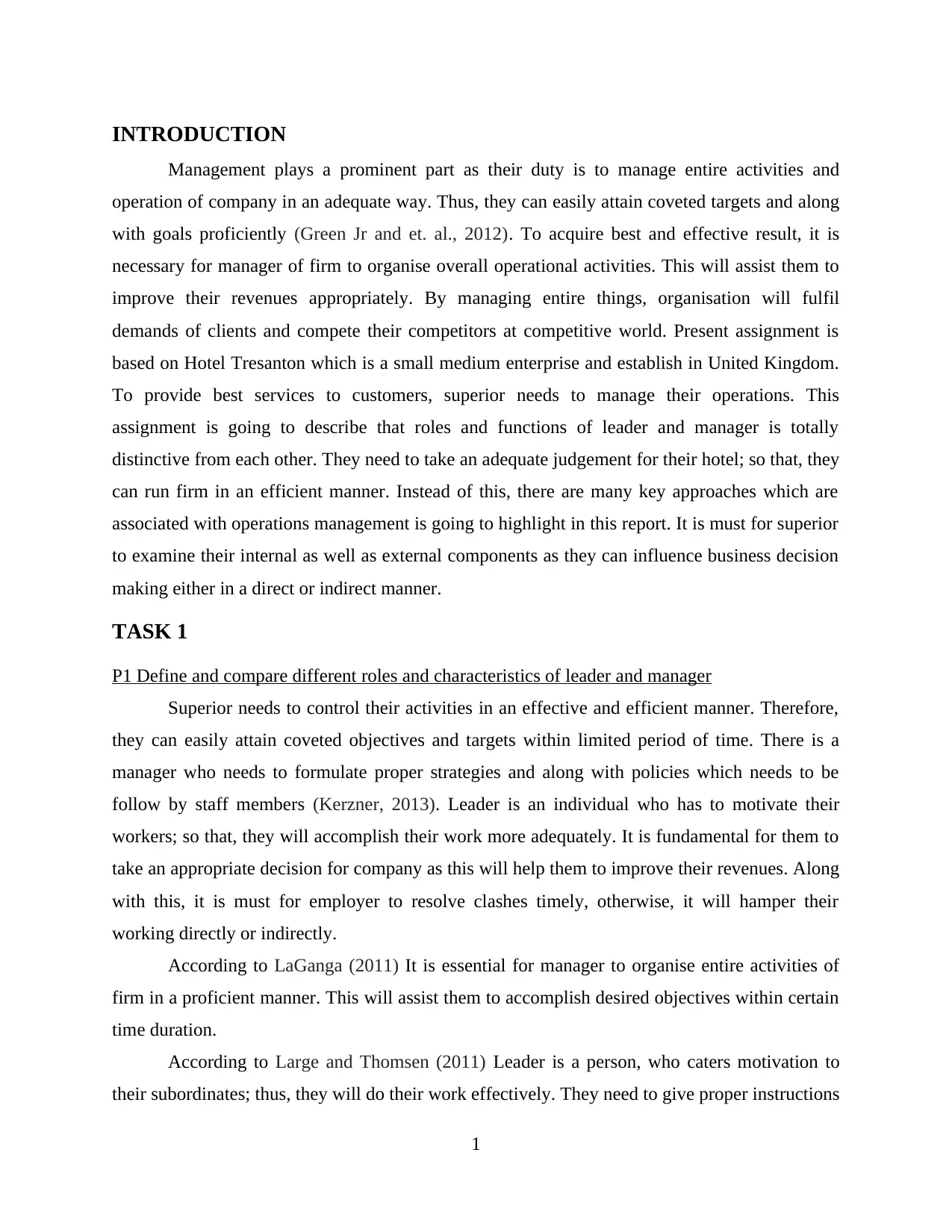
INTRODUCTION
Management plays a prominent part as their duty is to manage entire activities and
operation of company in an adequate way. Thus, they can easily attain coveted targets and along
with goals proficiently (Green Jr and et. al., 2012). To acquire best and effective result, it is
necessary for manager of firm to organise overall operational activities. This will assist them to
improve their revenues appropriately. By managing entire things, organisation will fulfil
demands of clients and compete their competitors at competitive world. Present assignment is
based on Hotel Tresanton which is a small medium enterprise and establish in United Kingdom.
To provide best services to customers, superior needs to manage their operations. This
assignment is going to describe that roles and functions of leader and manager is totally
distinctive from each other. They need to take an adequate judgement for their hotel; so that, they
can run firm in an efficient manner. Instead of this, there are many key approaches which are
associated with operations management is going to highlight in this report. It is must for superior
to examine their internal as well as external components as they can influence business decision
making either in a direct or indirect manner.
TASK 1
P1 Define and compare different roles and characteristics of leader and manager
Superior needs to control their activities in an effective and efficient manner. Therefore,
they can easily attain coveted objectives and targets within limited period of time. There is a
manager who needs to formulate proper strategies and along with policies which needs to be
follow by staff members (Kerzner, 2013). Leader is an individual who has to motivate their
workers; so that, they will accomplish their work more adequately. It is fundamental for them to
take an appropriate decision for company as this will help them to improve their revenues. Along
with this, it is must for employer to resolve clashes timely, otherwise, it will hamper their
working directly or indirectly.
According to LaGanga (2011) It is essential for manager to organise entire activities of
firm in a proficient manner. This will assist them to accomplish desired objectives within certain
time duration.
According to Large and Thomsen (2011) Leader is a person, who caters motivation to
their subordinates; thus, they will do their work effectively. They need to give proper instructions
1
Management plays a prominent part as their duty is to manage entire activities and
operation of company in an adequate way. Thus, they can easily attain coveted targets and along
with goals proficiently (Green Jr and et. al., 2012). To acquire best and effective result, it is
necessary for manager of firm to organise overall operational activities. This will assist them to
improve their revenues appropriately. By managing entire things, organisation will fulfil
demands of clients and compete their competitors at competitive world. Present assignment is
based on Hotel Tresanton which is a small medium enterprise and establish in United Kingdom.
To provide best services to customers, superior needs to manage their operations. This
assignment is going to describe that roles and functions of leader and manager is totally
distinctive from each other. They need to take an adequate judgement for their hotel; so that, they
can run firm in an efficient manner. Instead of this, there are many key approaches which are
associated with operations management is going to highlight in this report. It is must for superior
to examine their internal as well as external components as they can influence business decision
making either in a direct or indirect manner.
TASK 1
P1 Define and compare different roles and characteristics of leader and manager
Superior needs to control their activities in an effective and efficient manner. Therefore,
they can easily attain coveted objectives and targets within limited period of time. There is a
manager who needs to formulate proper strategies and along with policies which needs to be
follow by staff members (Kerzner, 2013). Leader is an individual who has to motivate their
workers; so that, they will accomplish their work more adequately. It is fundamental for them to
take an appropriate decision for company as this will help them to improve their revenues. Along
with this, it is must for employer to resolve clashes timely, otherwise, it will hamper their
working directly or indirectly.
According to LaGanga (2011) It is essential for manager to organise entire activities of
firm in a proficient manner. This will assist them to accomplish desired objectives within certain
time duration.
According to Large and Thomsen (2011) Leader is a person, who caters motivation to
their subordinates; thus, they will do their work effectively. They need to give proper instructions
1
Paraphrase This Document
Need a fresh take? Get an instant paraphrase of this document with our AI Paraphraser
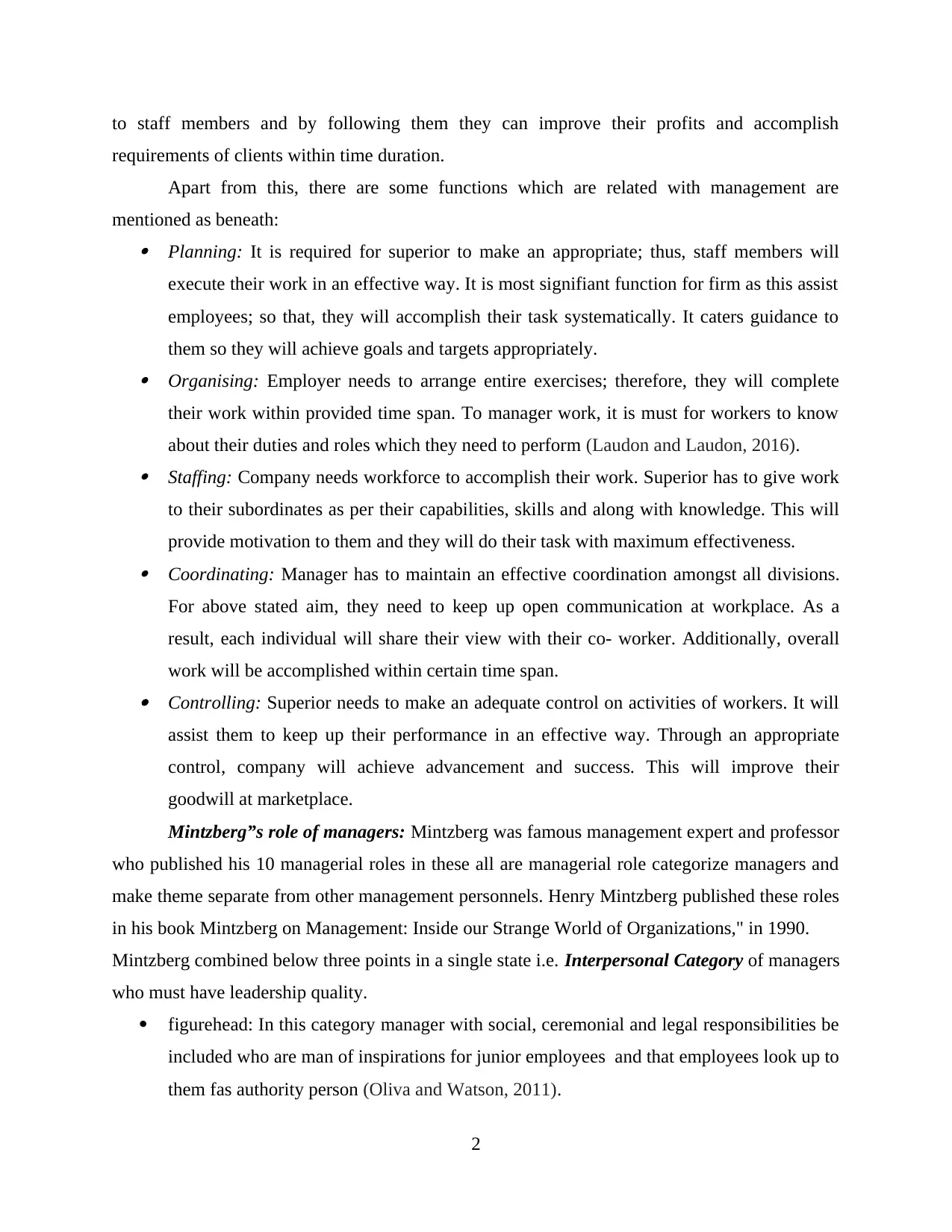
to staff members and by following them they can improve their profits and accomplish
requirements of clients within time duration.
Apart from this, there are some functions which are related with management are
mentioned as beneath: Planning: It is required for superior to make an appropriate; thus, staff members will
execute their work in an effective way. It is most signifiant function for firm as this assist
employees; so that, they will accomplish their task systematically. It caters guidance to
them so they will achieve goals and targets appropriately. Organising: Employer needs to arrange entire exercises; therefore, they will complete
their work within provided time span. To manager work, it is must for workers to know
about their duties and roles which they need to perform (Laudon and Laudon, 2016). Staffing: Company needs workforce to accomplish their work. Superior has to give work
to their subordinates as per their capabilities, skills and along with knowledge. This will
provide motivation to them and they will do their task with maximum effectiveness. Coordinating: Manager has to maintain an effective coordination amongst all divisions.
For above stated aim, they need to keep up open communication at workplace. As a
result, each individual will share their view with their co- worker. Additionally, overall
work will be accomplished within certain time span. Controlling: Superior needs to make an adequate control on activities of workers. It will
assist them to keep up their performance in an effective way. Through an appropriate
control, company will achieve advancement and success. This will improve their
goodwill at marketplace.
Mintzberg”s role of managers: Mintzberg was famous management expert and professor
who published his 10 managerial roles in these all are managerial role categorize managers and
make theme separate from other management personnels. Henry Mintzberg published these roles
in his book Mintzberg on Management: Inside our Strange World of Organizations," in 1990.
Mintzberg combined below three points in a single state i.e. Interpersonal Category of managers
who must have leadership quality.
figurehead: In this category manager with social, ceremonial and legal responsibilities be
included who are man of inspirations for junior employees and that employees look up to
them fas authority person (Oliva and Watson, 2011).
2
requirements of clients within time duration.
Apart from this, there are some functions which are related with management are
mentioned as beneath: Planning: It is required for superior to make an appropriate; thus, staff members will
execute their work in an effective way. It is most signifiant function for firm as this assist
employees; so that, they will accomplish their task systematically. It caters guidance to
them so they will achieve goals and targets appropriately. Organising: Employer needs to arrange entire exercises; therefore, they will complete
their work within provided time span. To manager work, it is must for workers to know
about their duties and roles which they need to perform (Laudon and Laudon, 2016). Staffing: Company needs workforce to accomplish their work. Superior has to give work
to their subordinates as per their capabilities, skills and along with knowledge. This will
provide motivation to them and they will do their task with maximum effectiveness. Coordinating: Manager has to maintain an effective coordination amongst all divisions.
For above stated aim, they need to keep up open communication at workplace. As a
result, each individual will share their view with their co- worker. Additionally, overall
work will be accomplished within certain time span. Controlling: Superior needs to make an adequate control on activities of workers. It will
assist them to keep up their performance in an effective way. Through an appropriate
control, company will achieve advancement and success. This will improve their
goodwill at marketplace.
Mintzberg”s role of managers: Mintzberg was famous management expert and professor
who published his 10 managerial roles in these all are managerial role categorize managers and
make theme separate from other management personnels. Henry Mintzberg published these roles
in his book Mintzberg on Management: Inside our Strange World of Organizations," in 1990.
Mintzberg combined below three points in a single state i.e. Interpersonal Category of managers
who must have leadership quality.
figurehead: In this category manager with social, ceremonial and legal responsibilities be
included who are man of inspirations for junior employees and that employees look up to
them fas authority person (Oliva and Watson, 2011).
2
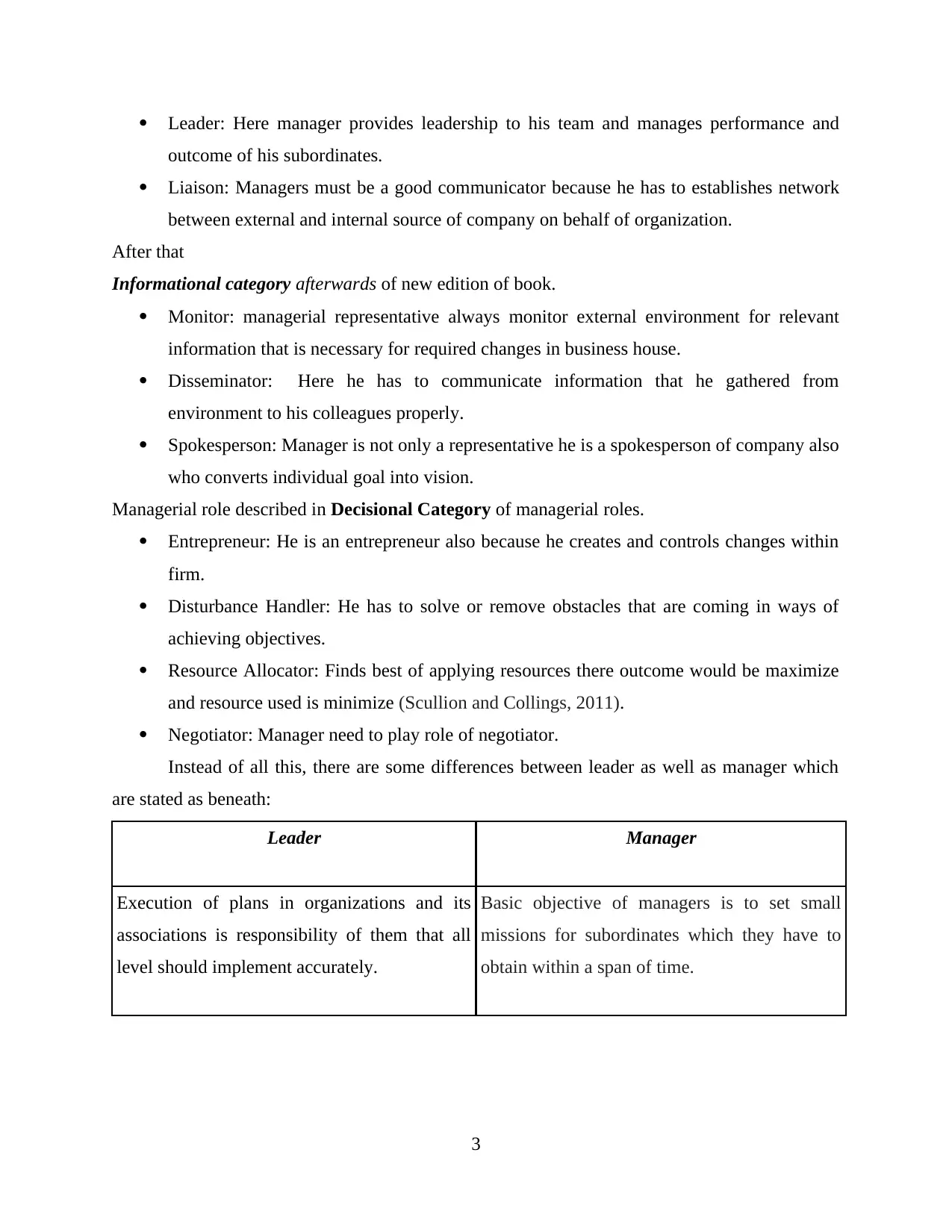
Leader: Here manager provides leadership to his team and manages performance and
outcome of his subordinates.
Liaison: Managers must be a good communicator because he has to establishes network
between external and internal source of company on behalf of organization.
After that
Informational category afterwards of new edition of book.
Monitor: managerial representative always monitor external environment for relevant
information that is necessary for required changes in business house.
Disseminator: Here he has to communicate information that he gathered from
environment to his colleagues properly.
Spokesperson: Manager is not only a representative he is a spokesperson of company also
who converts individual goal into vision.
Managerial role described in Decisional Category of managerial roles.
Entrepreneur: He is an entrepreneur also because he creates and controls changes within
firm.
Disturbance Handler: He has to solve or remove obstacles that are coming in ways of
achieving objectives.
Resource Allocator: Finds best of applying resources there outcome would be maximize
and resource used is minimize (Scullion and Collings, 2011).
Negotiator: Manager need to play role of negotiator.
Instead of all this, there are some differences between leader as well as manager which
are stated as beneath:
Leader Manager
Execution of plans in organizations and its
associations is responsibility of them that all
level should implement accurately.
Basic objective of managers is to set small
missions for subordinates which they have to
obtain within a span of time.
3
outcome of his subordinates.
Liaison: Managers must be a good communicator because he has to establishes network
between external and internal source of company on behalf of organization.
After that
Informational category afterwards of new edition of book.
Monitor: managerial representative always monitor external environment for relevant
information that is necessary for required changes in business house.
Disseminator: Here he has to communicate information that he gathered from
environment to his colleagues properly.
Spokesperson: Manager is not only a representative he is a spokesperson of company also
who converts individual goal into vision.
Managerial role described in Decisional Category of managerial roles.
Entrepreneur: He is an entrepreneur also because he creates and controls changes within
firm.
Disturbance Handler: He has to solve or remove obstacles that are coming in ways of
achieving objectives.
Resource Allocator: Finds best of applying resources there outcome would be maximize
and resource used is minimize (Scullion and Collings, 2011).
Negotiator: Manager need to play role of negotiator.
Instead of all this, there are some differences between leader as well as manager which
are stated as beneath:
Leader Manager
Execution of plans in organizations and its
associations is responsibility of them that all
level should implement accurately.
Basic objective of managers is to set small
missions for subordinates which they have to
obtain within a span of time.
3
⊘ This is a preview!⊘
Do you want full access?
Subscribe today to unlock all pages.

Trusted by 1+ million students worldwide
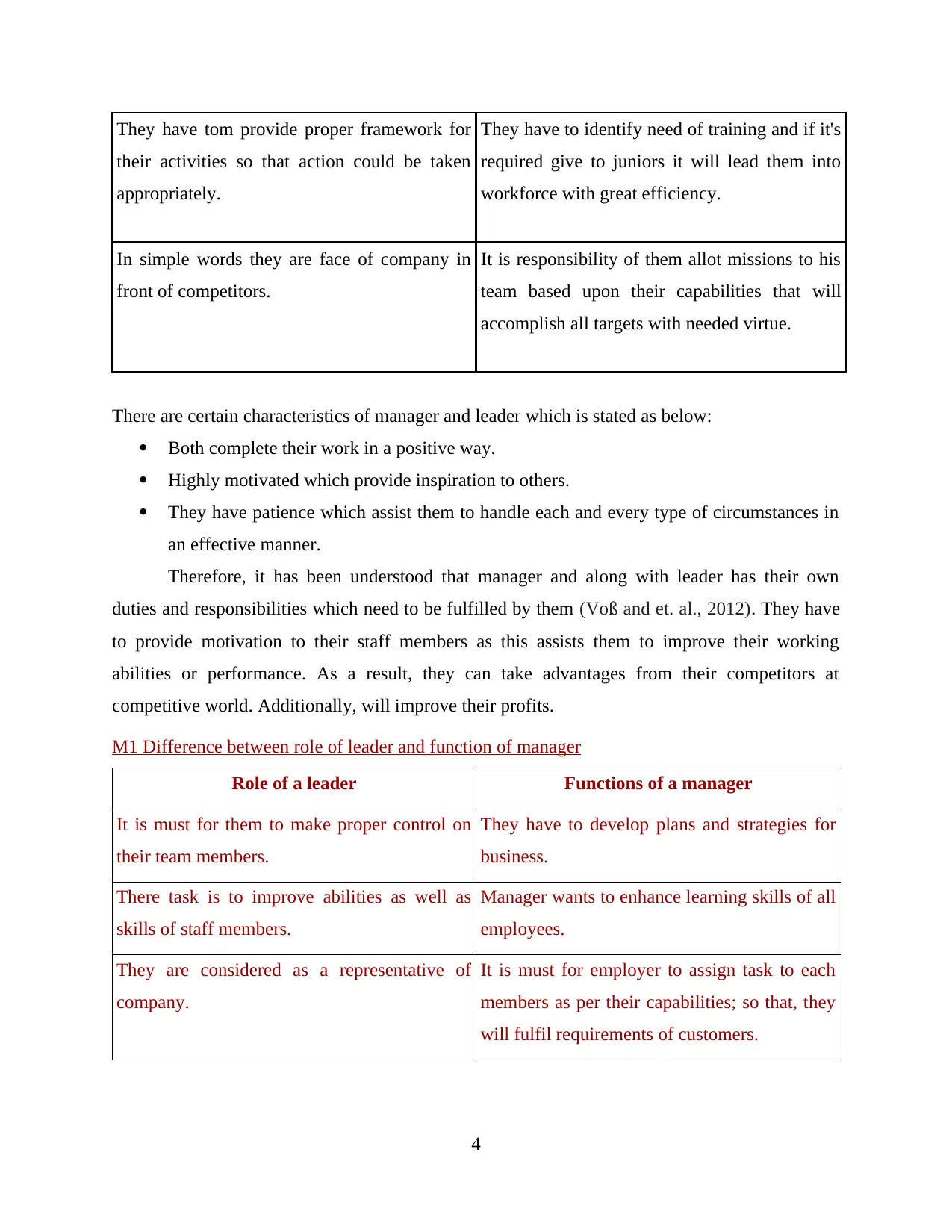
They have tom provide proper framework for
their activities so that action could be taken
appropriately.
They have to identify need of training and if it's
required give to juniors it will lead them into
workforce with great efficiency.
In simple words they are face of company in
front of competitors.
It is responsibility of them allot missions to his
team based upon their capabilities that will
accomplish all targets with needed virtue.
There are certain characteristics of manager and leader which is stated as below:
Both complete their work in a positive way.
Highly motivated which provide inspiration to others.
They have patience which assist them to handle each and every type of circumstances in
an effective manner.
Therefore, it has been understood that manager and along with leader has their own
duties and responsibilities which need to be fulfilled by them (Voß and et. al., 2012). They have
to provide motivation to their staff members as this assists them to improve their working
abilities or performance. As a result, they can take advantages from their competitors at
competitive world. Additionally, will improve their profits.
M1 Difference between role of leader and function of manager
Role of a leader Functions of a manager
It is must for them to make proper control on
their team members.
They have to develop plans and strategies for
business.
There task is to improve abilities as well as
skills of staff members.
Manager wants to enhance learning skills of all
employees.
They are considered as a representative of
company.
It is must for employer to assign task to each
members as per their capabilities; so that, they
will fulfil requirements of customers.
4
their activities so that action could be taken
appropriately.
They have to identify need of training and if it's
required give to juniors it will lead them into
workforce with great efficiency.
In simple words they are face of company in
front of competitors.
It is responsibility of them allot missions to his
team based upon their capabilities that will
accomplish all targets with needed virtue.
There are certain characteristics of manager and leader which is stated as below:
Both complete their work in a positive way.
Highly motivated which provide inspiration to others.
They have patience which assist them to handle each and every type of circumstances in
an effective manner.
Therefore, it has been understood that manager and along with leader has their own
duties and responsibilities which need to be fulfilled by them (Voß and et. al., 2012). They have
to provide motivation to their staff members as this assists them to improve their working
abilities or performance. As a result, they can take advantages from their competitors at
competitive world. Additionally, will improve their profits.
M1 Difference between role of leader and function of manager
Role of a leader Functions of a manager
It is must for them to make proper control on
their team members.
They have to develop plans and strategies for
business.
There task is to improve abilities as well as
skills of staff members.
Manager wants to enhance learning skills of all
employees.
They are considered as a representative of
company.
It is must for employer to assign task to each
members as per their capabilities; so that, they
will fulfil requirements of customers.
4
Paraphrase This Document
Need a fresh take? Get an instant paraphrase of this document with our AI Paraphraser
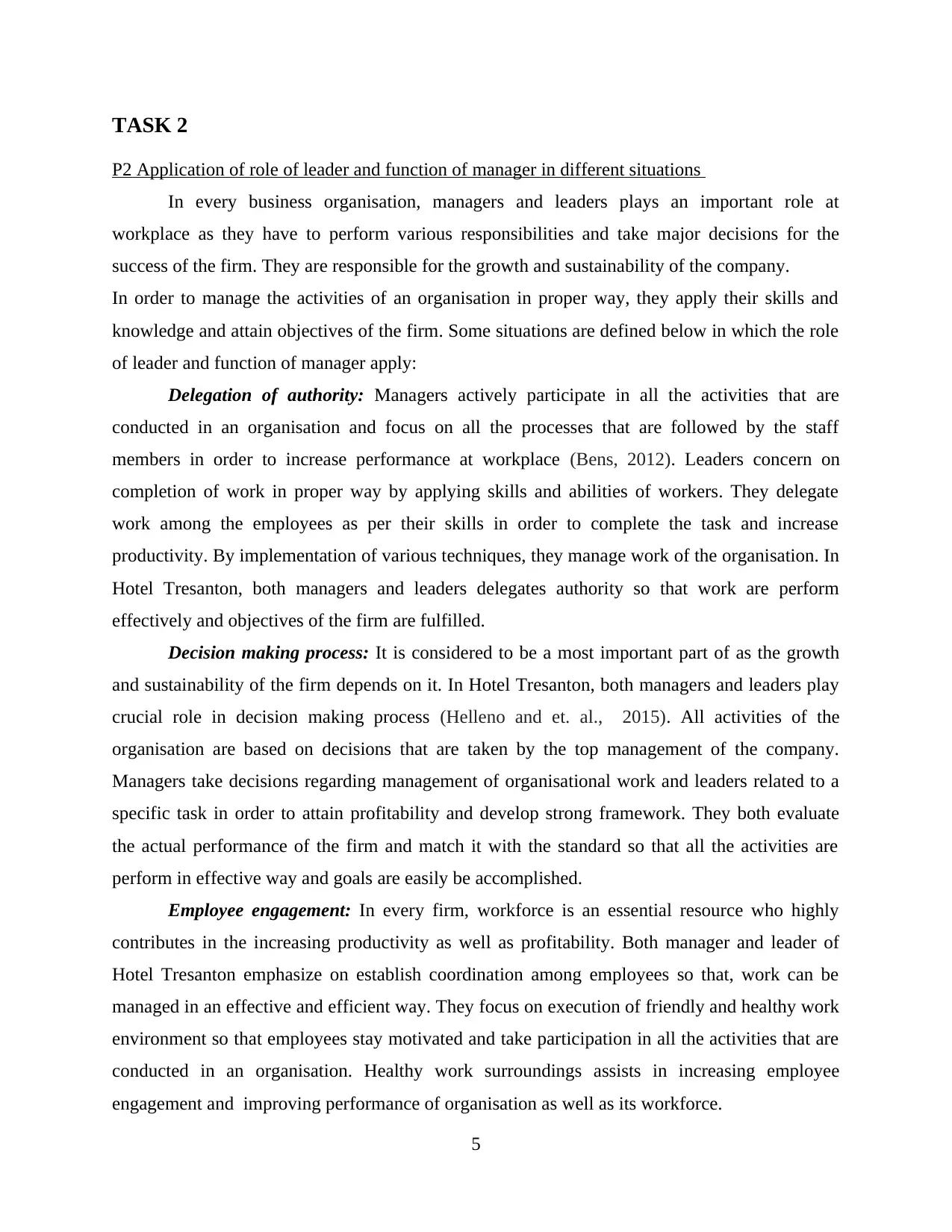
TASK 2
P2 Application of role of leader and function of manager in different situations
In every business organisation, managers and leaders plays an important role at
workplace as they have to perform various responsibilities and take major decisions for the
success of the firm. They are responsible for the growth and sustainability of the company.
In order to manage the activities of an organisation in proper way, they apply their skills and
knowledge and attain objectives of the firm. Some situations are defined below in which the role
of leader and function of manager apply:
Delegation of authority: Managers actively participate in all the activities that are
conducted in an organisation and focus on all the processes that are followed by the staff
members in order to increase performance at workplace (Bens, 2012). Leaders concern on
completion of work in proper way by applying skills and abilities of workers. They delegate
work among the employees as per their skills in order to complete the task and increase
productivity. By implementation of various techniques, they manage work of the organisation. In
Hotel Tresanton, both managers and leaders delegates authority so that work are perform
effectively and objectives of the firm are fulfilled.
Decision making process: It is considered to be a most important part of as the growth
and sustainability of the firm depends on it. In Hotel Tresanton, both managers and leaders play
crucial role in decision making process (Helleno and et. al., 2015). All activities of the
organisation are based on decisions that are taken by the top management of the company.
Managers take decisions regarding management of organisational work and leaders related to a
specific task in order to attain profitability and develop strong framework. They both evaluate
the actual performance of the firm and match it with the standard so that all the activities are
perform in effective way and goals are easily be accomplished.
Employee engagement: In every firm, workforce is an essential resource who highly
contributes in the increasing productivity as well as profitability. Both manager and leader of
Hotel Tresanton emphasize on establish coordination among employees so that, work can be
managed in an effective and efficient way. They focus on execution of friendly and healthy work
environment so that employees stay motivated and take participation in all the activities that are
conducted in an organisation. Healthy work surroundings assists in increasing employee
engagement and improving performance of organisation as well as its workforce.
5
P2 Application of role of leader and function of manager in different situations
In every business organisation, managers and leaders plays an important role at
workplace as they have to perform various responsibilities and take major decisions for the
success of the firm. They are responsible for the growth and sustainability of the company.
In order to manage the activities of an organisation in proper way, they apply their skills and
knowledge and attain objectives of the firm. Some situations are defined below in which the role
of leader and function of manager apply:
Delegation of authority: Managers actively participate in all the activities that are
conducted in an organisation and focus on all the processes that are followed by the staff
members in order to increase performance at workplace (Bens, 2012). Leaders concern on
completion of work in proper way by applying skills and abilities of workers. They delegate
work among the employees as per their skills in order to complete the task and increase
productivity. By implementation of various techniques, they manage work of the organisation. In
Hotel Tresanton, both managers and leaders delegates authority so that work are perform
effectively and objectives of the firm are fulfilled.
Decision making process: It is considered to be a most important part of as the growth
and sustainability of the firm depends on it. In Hotel Tresanton, both managers and leaders play
crucial role in decision making process (Helleno and et. al., 2015). All activities of the
organisation are based on decisions that are taken by the top management of the company.
Managers take decisions regarding management of organisational work and leaders related to a
specific task in order to attain profitability and develop strong framework. They both evaluate
the actual performance of the firm and match it with the standard so that all the activities are
perform in effective way and goals are easily be accomplished.
Employee engagement: In every firm, workforce is an essential resource who highly
contributes in the increasing productivity as well as profitability. Both manager and leader of
Hotel Tresanton emphasize on establish coordination among employees so that, work can be
managed in an effective and efficient way. They focus on execution of friendly and healthy work
environment so that employees stay motivated and take participation in all the activities that are
conducted in an organisation. Healthy work surroundings assists in increasing employee
engagement and improving performance of organisation as well as its workforce.
5
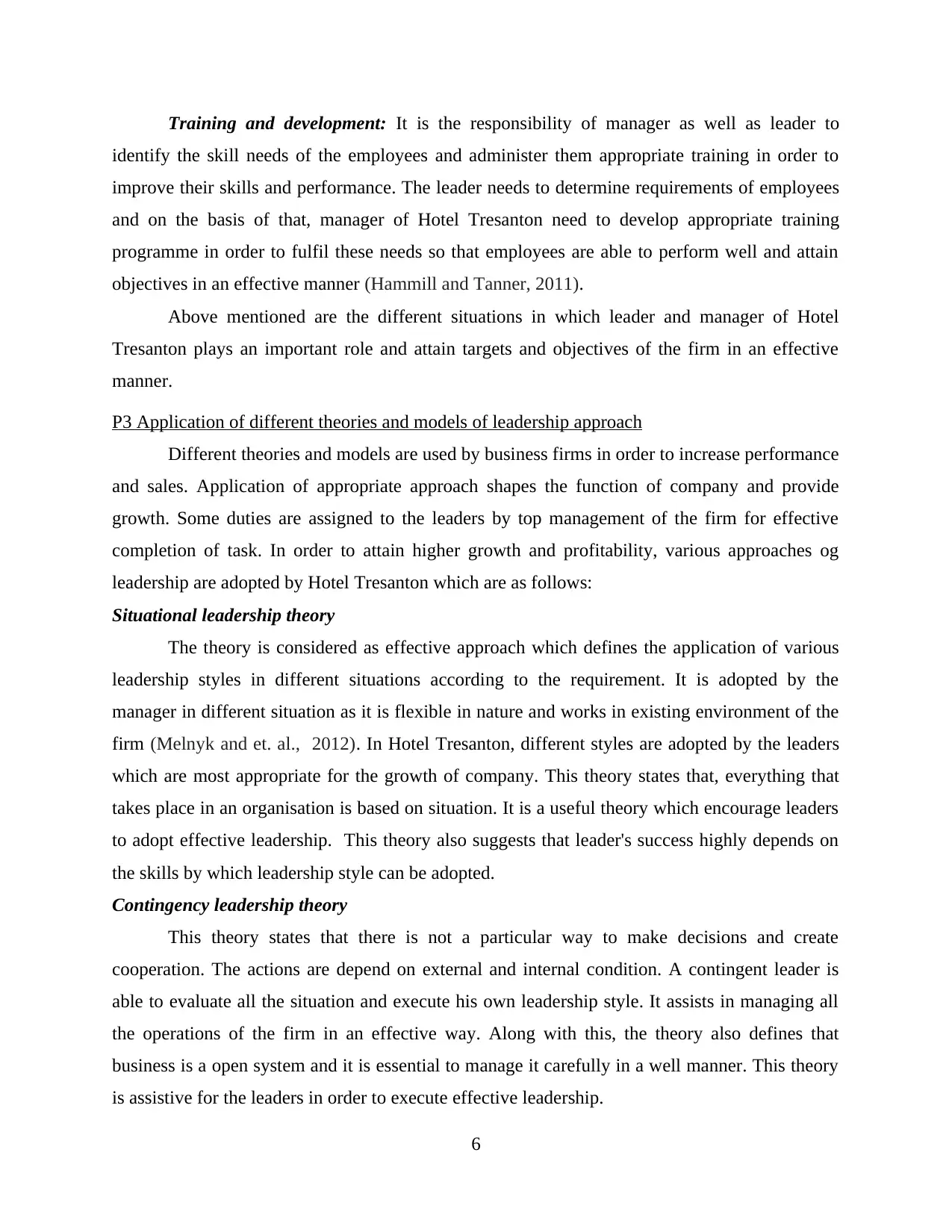
Training and development: It is the responsibility of manager as well as leader to
identify the skill needs of the employees and administer them appropriate training in order to
improve their skills and performance. The leader needs to determine requirements of employees
and on the basis of that, manager of Hotel Tresanton need to develop appropriate training
programme in order to fulfil these needs so that employees are able to perform well and attain
objectives in an effective manner (Hammill and Tanner, 2011).
Above mentioned are the different situations in which leader and manager of Hotel
Tresanton plays an important role and attain targets and objectives of the firm in an effective
manner.
P3 Application of different theories and models of leadership approach
Different theories and models are used by business firms in order to increase performance
and sales. Application of appropriate approach shapes the function of company and provide
growth. Some duties are assigned to the leaders by top management of the firm for effective
completion of task. In order to attain higher growth and profitability, various approaches og
leadership are adopted by Hotel Tresanton which are as follows:
Situational leadership theory
The theory is considered as effective approach which defines the application of various
leadership styles in different situations according to the requirement. It is adopted by the
manager in different situation as it is flexible in nature and works in existing environment of the
firm (Melnyk and et. al., 2012). In Hotel Tresanton, different styles are adopted by the leaders
which are most appropriate for the growth of company. This theory states that, everything that
takes place in an organisation is based on situation. It is a useful theory which encourage leaders
to adopt effective leadership. This theory also suggests that leader's success highly depends on
the skills by which leadership style can be adopted.
Contingency leadership theory
This theory states that there is not a particular way to make decisions and create
cooperation. The actions are depend on external and internal condition. A contingent leader is
able to evaluate all the situation and execute his own leadership style. It assists in managing all
the operations of the firm in an effective way. Along with this, the theory also defines that
business is a open system and it is essential to manage it carefully in a well manner. This theory
is assistive for the leaders in order to execute effective leadership.
6
identify the skill needs of the employees and administer them appropriate training in order to
improve their skills and performance. The leader needs to determine requirements of employees
and on the basis of that, manager of Hotel Tresanton need to develop appropriate training
programme in order to fulfil these needs so that employees are able to perform well and attain
objectives in an effective manner (Hammill and Tanner, 2011).
Above mentioned are the different situations in which leader and manager of Hotel
Tresanton plays an important role and attain targets and objectives of the firm in an effective
manner.
P3 Application of different theories and models of leadership approach
Different theories and models are used by business firms in order to increase performance
and sales. Application of appropriate approach shapes the function of company and provide
growth. Some duties are assigned to the leaders by top management of the firm for effective
completion of task. In order to attain higher growth and profitability, various approaches og
leadership are adopted by Hotel Tresanton which are as follows:
Situational leadership theory
The theory is considered as effective approach which defines the application of various
leadership styles in different situations according to the requirement. It is adopted by the
manager in different situation as it is flexible in nature and works in existing environment of the
firm (Melnyk and et. al., 2012). In Hotel Tresanton, different styles are adopted by the leaders
which are most appropriate for the growth of company. This theory states that, everything that
takes place in an organisation is based on situation. It is a useful theory which encourage leaders
to adopt effective leadership. This theory also suggests that leader's success highly depends on
the skills by which leadership style can be adopted.
Contingency leadership theory
This theory states that there is not a particular way to make decisions and create
cooperation. The actions are depend on external and internal condition. A contingent leader is
able to evaluate all the situation and execute his own leadership style. It assists in managing all
the operations of the firm in an effective way. Along with this, the theory also defines that
business is a open system and it is essential to manage it carefully in a well manner. This theory
is assistive for the leaders in order to execute effective leadership.
6
⊘ This is a preview!⊘
Do you want full access?
Subscribe today to unlock all pages.

Trusted by 1+ million students worldwide
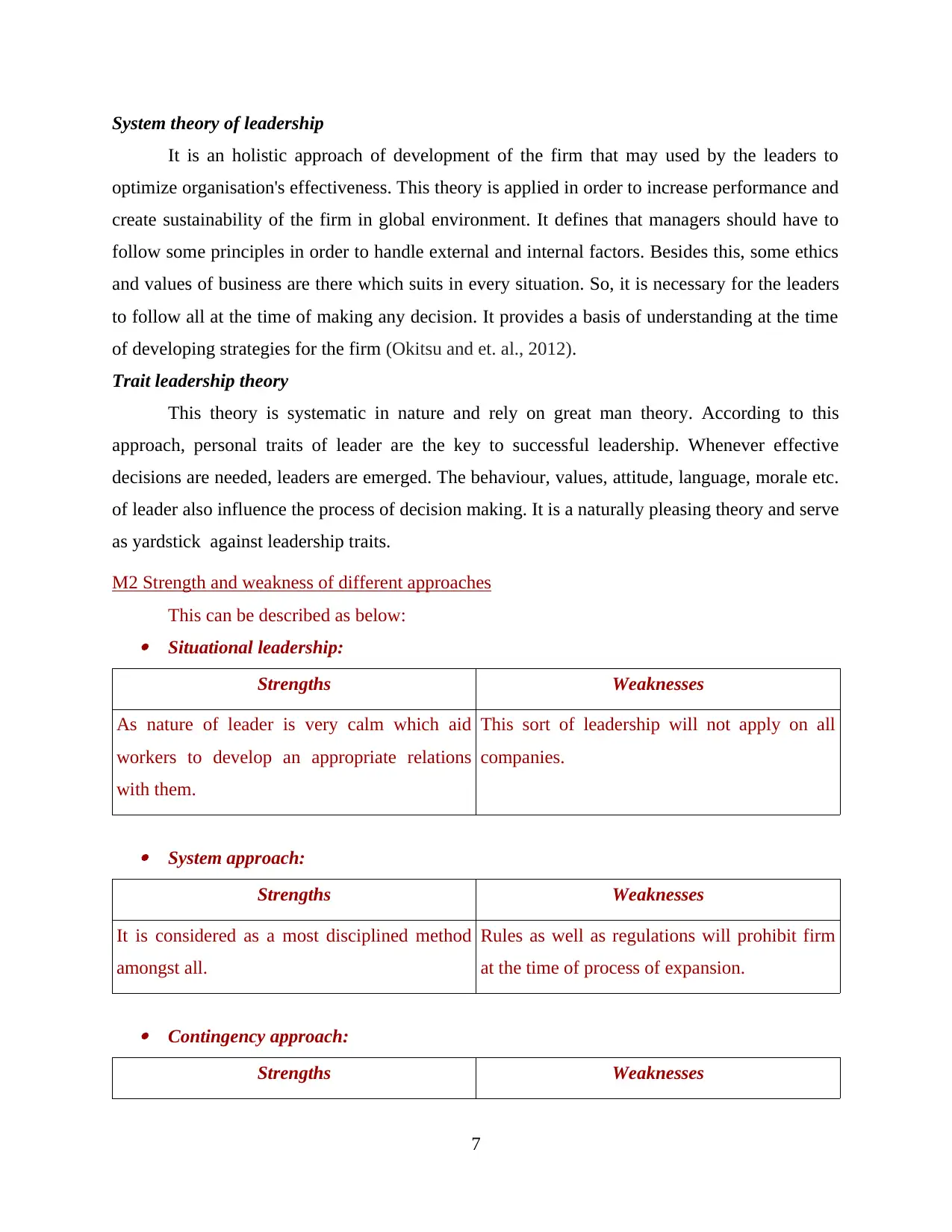
System theory of leadership
It is an holistic approach of development of the firm that may used by the leaders to
optimize organisation's effectiveness. This theory is applied in order to increase performance and
create sustainability of the firm in global environment. It defines that managers should have to
follow some principles in order to handle external and internal factors. Besides this, some ethics
and values of business are there which suits in every situation. So, it is necessary for the leaders
to follow all at the time of making any decision. It provides a basis of understanding at the time
of developing strategies for the firm (Okitsu and et. al., 2012).
Trait leadership theory
This theory is systematic in nature and rely on great man theory. According to this
approach, personal traits of leader are the key to successful leadership. Whenever effective
decisions are needed, leaders are emerged. The behaviour, values, attitude, language, morale etc.
of leader also influence the process of decision making. It is a naturally pleasing theory and serve
as yardstick against leadership traits.
M2 Strength and weakness of different approaches
This can be described as below: Situational leadership:
Strengths Weaknesses
As nature of leader is very calm which aid
workers to develop an appropriate relations
with them.
This sort of leadership will not apply on all
companies.
System approach:
Strengths Weaknesses
It is considered as a most disciplined method
amongst all.
Rules as well as regulations will prohibit firm
at the time of process of expansion.
Contingency approach:
Strengths Weaknesses
7
It is an holistic approach of development of the firm that may used by the leaders to
optimize organisation's effectiveness. This theory is applied in order to increase performance and
create sustainability of the firm in global environment. It defines that managers should have to
follow some principles in order to handle external and internal factors. Besides this, some ethics
and values of business are there which suits in every situation. So, it is necessary for the leaders
to follow all at the time of making any decision. It provides a basis of understanding at the time
of developing strategies for the firm (Okitsu and et. al., 2012).
Trait leadership theory
This theory is systematic in nature and rely on great man theory. According to this
approach, personal traits of leader are the key to successful leadership. Whenever effective
decisions are needed, leaders are emerged. The behaviour, values, attitude, language, morale etc.
of leader also influence the process of decision making. It is a naturally pleasing theory and serve
as yardstick against leadership traits.
M2 Strength and weakness of different approaches
This can be described as below: Situational leadership:
Strengths Weaknesses
As nature of leader is very calm which aid
workers to develop an appropriate relations
with them.
This sort of leadership will not apply on all
companies.
System approach:
Strengths Weaknesses
It is considered as a most disciplined method
amongst all.
Rules as well as regulations will prohibit firm
at the time of process of expansion.
Contingency approach:
Strengths Weaknesses
7
Paraphrase This Document
Need a fresh take? Get an instant paraphrase of this document with our AI Paraphraser
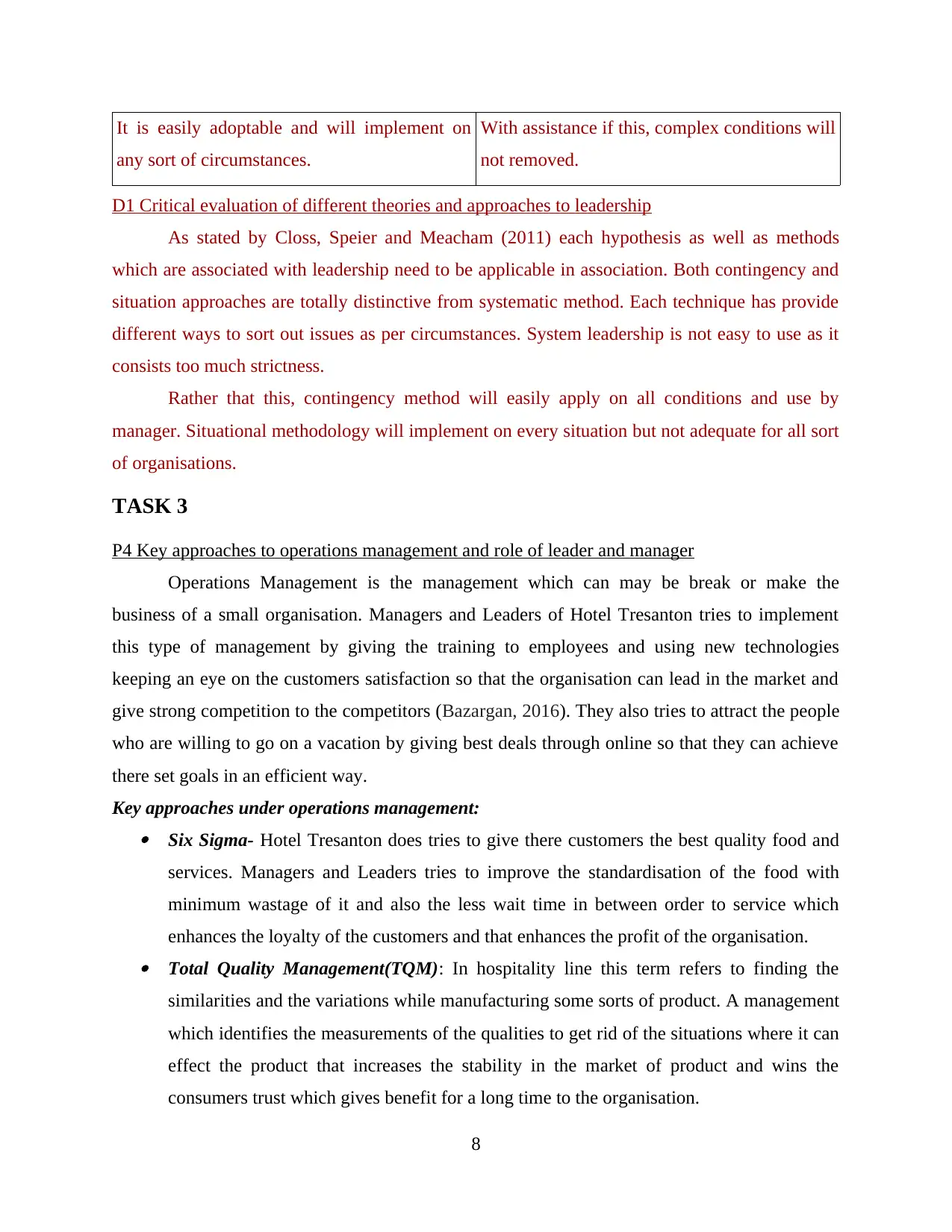
It is easily adoptable and will implement on
any sort of circumstances.
With assistance if this, complex conditions will
not removed.
D1 Critical evaluation of different theories and approaches to leadership
As stated by Closs, Speier and Meacham (2011) each hypothesis as well as methods
which are associated with leadership need to be applicable in association. Both contingency and
situation approaches are totally distinctive from systematic method. Each technique has provide
different ways to sort out issues as per circumstances. System leadership is not easy to use as it
consists too much strictness.
Rather that this, contingency method will easily apply on all conditions and use by
manager. Situational methodology will implement on every situation but not adequate for all sort
of organisations.
TASK 3
P4 Key approaches to operations management and role of leader and manager
Operations Management is the management which can may be break or make the
business of a small organisation. Managers and Leaders of Hotel Tresanton tries to implement
this type of management by giving the training to employees and using new technologies
keeping an eye on the customers satisfaction so that the organisation can lead in the market and
give strong competition to the competitors (Bazargan, 2016). They also tries to attract the people
who are willing to go on a vacation by giving best deals through online so that they can achieve
there set goals in an efficient way.
Key approaches under operations management: Six Sigma- Hotel Tresanton does tries to give there customers the best quality food and
services. Managers and Leaders tries to improve the standardisation of the food with
minimum wastage of it and also the less wait time in between order to service which
enhances the loyalty of the customers and that enhances the profit of the organisation. Total Quality Management(TQM): In hospitality line this term refers to finding the
similarities and the variations while manufacturing some sorts of product. A management
which identifies the measurements of the qualities to get rid of the situations where it can
effect the product that increases the stability in the market of product and wins the
consumers trust which gives benefit for a long time to the organisation.
8
any sort of circumstances.
With assistance if this, complex conditions will
not removed.
D1 Critical evaluation of different theories and approaches to leadership
As stated by Closs, Speier and Meacham (2011) each hypothesis as well as methods
which are associated with leadership need to be applicable in association. Both contingency and
situation approaches are totally distinctive from systematic method. Each technique has provide
different ways to sort out issues as per circumstances. System leadership is not easy to use as it
consists too much strictness.
Rather that this, contingency method will easily apply on all conditions and use by
manager. Situational methodology will implement on every situation but not adequate for all sort
of organisations.
TASK 3
P4 Key approaches to operations management and role of leader and manager
Operations Management is the management which can may be break or make the
business of a small organisation. Managers and Leaders of Hotel Tresanton tries to implement
this type of management by giving the training to employees and using new technologies
keeping an eye on the customers satisfaction so that the organisation can lead in the market and
give strong competition to the competitors (Bazargan, 2016). They also tries to attract the people
who are willing to go on a vacation by giving best deals through online so that they can achieve
there set goals in an efficient way.
Key approaches under operations management: Six Sigma- Hotel Tresanton does tries to give there customers the best quality food and
services. Managers and Leaders tries to improve the standardisation of the food with
minimum wastage of it and also the less wait time in between order to service which
enhances the loyalty of the customers and that enhances the profit of the organisation. Total Quality Management(TQM): In hospitality line this term refers to finding the
similarities and the variations while manufacturing some sorts of product. A management
which identifies the measurements of the qualities to get rid of the situations where it can
effect the product that increases the stability in the market of product and wins the
consumers trust which gives benefit for a long time to the organisation.
8
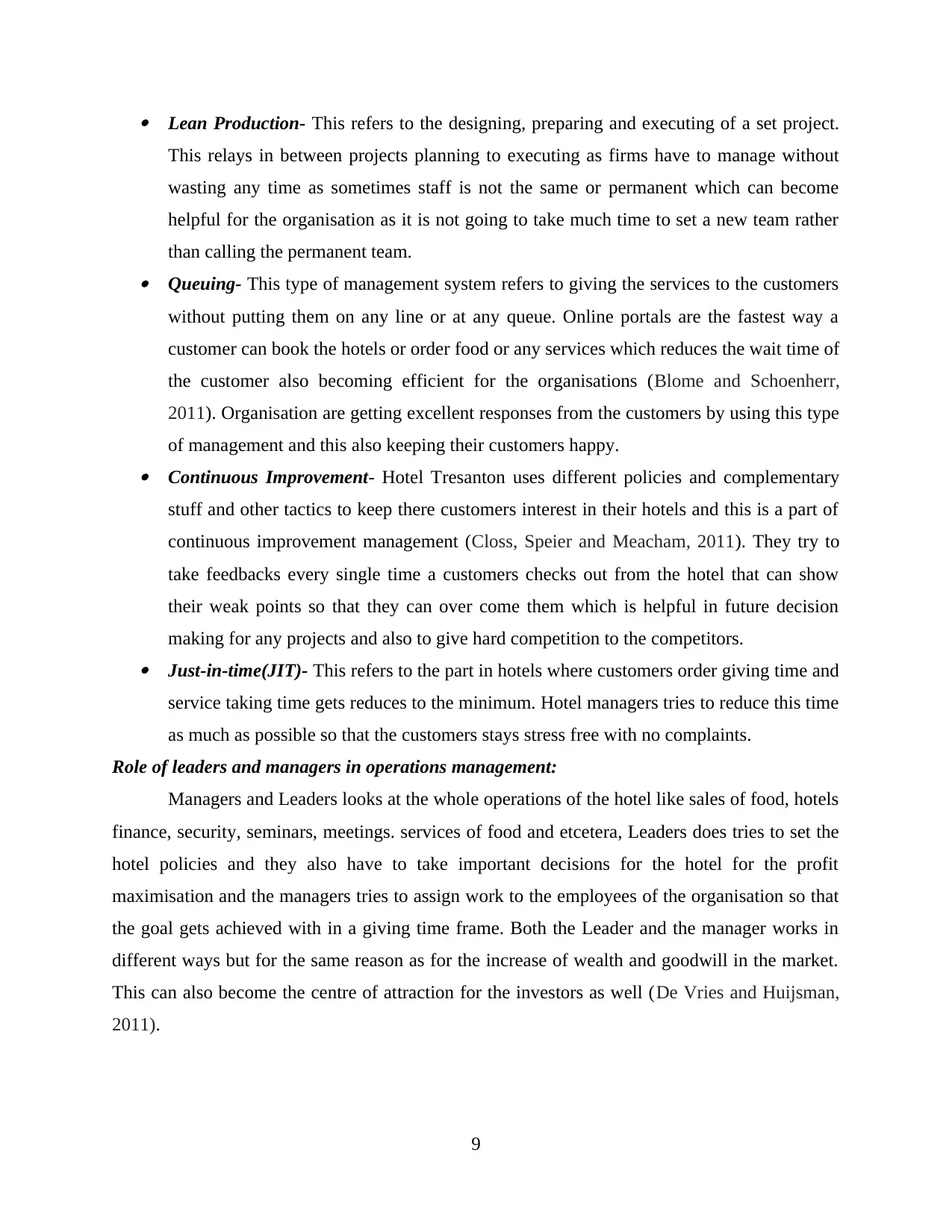
Lean Production- This refers to the designing, preparing and executing of a set project.
This relays in between projects planning to executing as firms have to manage without
wasting any time as sometimes staff is not the same or permanent which can become
helpful for the organisation as it is not going to take much time to set a new team rather
than calling the permanent team. Queuing- This type of management system refers to giving the services to the customers
without putting them on any line or at any queue. Online portals are the fastest way a
customer can book the hotels or order food or any services which reduces the wait time of
the customer also becoming efficient for the organisations (Blome and Schoenherr,
2011). Organisation are getting excellent responses from the customers by using this type
of management and this also keeping their customers happy. Continuous Improvement- Hotel Tresanton uses different policies and complementary
stuff and other tactics to keep there customers interest in their hotels and this is a part of
continuous improvement management (Closs, Speier and Meacham, 2011). They try to
take feedbacks every single time a customers checks out from the hotel that can show
their weak points so that they can over come them which is helpful in future decision
making for any projects and also to give hard competition to the competitors. Just-in-time(JIT)- This refers to the part in hotels where customers order giving time and
service taking time gets reduces to the minimum. Hotel managers tries to reduce this time
as much as possible so that the customers stays stress free with no complaints.
Role of leaders and managers in operations management:
Managers and Leaders looks at the whole operations of the hotel like sales of food, hotels
finance, security, seminars, meetings. services of food and etcetera, Leaders does tries to set the
hotel policies and they also have to take important decisions for the hotel for the profit
maximisation and the managers tries to assign work to the employees of the organisation so that
the goal gets achieved with in a giving time frame. Both the Leader and the manager works in
different ways but for the same reason as for the increase of wealth and goodwill in the market.
This can also become the centre of attraction for the investors as well (De Vries and Huijsman,
2011).
9
This relays in between projects planning to executing as firms have to manage without
wasting any time as sometimes staff is not the same or permanent which can become
helpful for the organisation as it is not going to take much time to set a new team rather
than calling the permanent team. Queuing- This type of management system refers to giving the services to the customers
without putting them on any line or at any queue. Online portals are the fastest way a
customer can book the hotels or order food or any services which reduces the wait time of
the customer also becoming efficient for the organisations (Blome and Schoenherr,
2011). Organisation are getting excellent responses from the customers by using this type
of management and this also keeping their customers happy. Continuous Improvement- Hotel Tresanton uses different policies and complementary
stuff and other tactics to keep there customers interest in their hotels and this is a part of
continuous improvement management (Closs, Speier and Meacham, 2011). They try to
take feedbacks every single time a customers checks out from the hotel that can show
their weak points so that they can over come them which is helpful in future decision
making for any projects and also to give hard competition to the competitors. Just-in-time(JIT)- This refers to the part in hotels where customers order giving time and
service taking time gets reduces to the minimum. Hotel managers tries to reduce this time
as much as possible so that the customers stays stress free with no complaints.
Role of leaders and managers in operations management:
Managers and Leaders looks at the whole operations of the hotel like sales of food, hotels
finance, security, seminars, meetings. services of food and etcetera, Leaders does tries to set the
hotel policies and they also have to take important decisions for the hotel for the profit
maximisation and the managers tries to assign work to the employees of the organisation so that
the goal gets achieved with in a giving time frame. Both the Leader and the manager works in
different ways but for the same reason as for the increase of wealth and goodwill in the market.
This can also become the centre of attraction for the investors as well (De Vries and Huijsman,
2011).
9
⊘ This is a preview!⊘
Do you want full access?
Subscribe today to unlock all pages.

Trusted by 1+ million students worldwide
1 out of 19
Related Documents
Your All-in-One AI-Powered Toolkit for Academic Success.
+13062052269
info@desklib.com
Available 24*7 on WhatsApp / Email
![[object Object]](/_next/static/media/star-bottom.7253800d.svg)
Unlock your academic potential
Copyright © 2020–2025 A2Z Services. All Rights Reserved. Developed and managed by ZUCOL.




